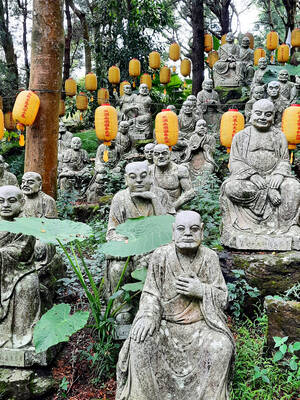The 27km walk along the A-Si Trail (阿溪縱走) is at once a journey through man’s attempt to tame and harvest the wilderness, as well as a powerful reminder of the forces of nature. Hikers walk on railway lines, forestry roads and small footpaths, passing tunnels, bridges and buildings, now regretfully abandoned after considerable earthquake and typhoon damage.
Even the land itself has been irrevocably changed by these natural disasters, with one section of river and its surrounding forest drowned by an earthquake. Yet there is one symbol of resilience: a giant cypress that has stood watch here for over 4,000 years, seemingly immune to the havoc and destruction surrounding it.
THE ALISHAN RAILWAY

Photo: Tyler Cottenie
Decades ago, the A-Si Trail was usually done in reverse, with hikers setting out from Nantou County’s Sitou area (溪頭) and walking up to Chiayi County’s Alishan Forest Railway’s most remote station, Shihhou (石猴). From there, hikers would proceed along the Mianyue Branch Line (眠月支線) into the Alishan Forest Recreation Area (阿里山國家森林遊樂區). At its opening a century ago, this was a logging line, but it later carried tourists in an old-fashioned steam locomotive.
In 1999, however, the 921 Earthquake damaged the branch line and hikers mostly abandoned this route. Despite a brief reopening after costly repairs, Typhoon Morakot sounded the final death knell for this line in 2009. A landslide sliced through one of the railway tunnels and is now one of the more thrilling — or terrifying, depending on the hiker — obstacles that must be overcome.
Nowadays, hikers usually begin in Alishan on foot. After half an hour walking on the Mianyue Line, the tunnel sliced open by Morakot is reached. Halfway through the tunnel, there is a chaotic jumble of chunks of concrete and twisted rebar, and then hikers are suddenly out in the open, with a wall of solid rock to one side and the remaining section of tunnel far ahead across a gaping chasm. Fortunately, sturdy hand and foot holds have been improvised from rebar and track remnants and the chasm can be crossed relatively safely.

Photo: Tyler Cottenie
After rejoining the railroad on the other side, the trail continues toward Shihhou Station. Since this is a rail line, the grade is nearly flat and the walking is easy. However, since this is a rail line, the bridges (of which there are 24) were not intended for pedestrian traffic and have neither railings nor a sturdy floor for walking. Each step must be made carefully along the narrow wooden plank between the rails or on the beams, while trying not to be dizzied by the view of the ground far below. Often the air at this elevation (2,300m) is saturated with fog and the longer bridges appear to disappear into the sky ahead. In one of the tunnels (of which there are 14), hikers have to climb up and over the rubble from a collapsed ceiling section in the dark, so be sure to bring a flashlight.
After three to four hours of walking through gorgeous coniferous forest and a nature reserve for an endemic orchid, the Taiwan Pleione, hikers pass by a trickling fresh water source and arrive at the line’s final passenger station, Shihhou Station. Its name refers to a stone outcropping in the mountain nearby that used to resemble a monkey, before it was decapitated by the 921 Earthquake. The slanting wooden shell of the station building remains and the level concrete floor under the protection of the roof is regarded as a prime campsite by hikers and snatched up early. Some make a day trip of the Mianyue Line and return to Alishan immediately, but A-Si hikers usually sleep here.
Beyond Shihhou the railroad continues, but this section only saw logging operations, never passenger service. In places, rails are suspended in midair like the cables of a suspension bridge with no deck, spanning areas where the railroad bed has been washed out by landslides. Soon, the A-Si Trail leaves the Alishan Railway behind, becoming a simple narrow footpath climbing steeply through the forest.

Photo: Tyler Cottenie
TREES, LARGE AND DROWNED
Peak baggers will enjoy the next part as the path climbs up to a 2,557-meter peak, Songshan (松山), and the forest opens up to a view of Jade Mountain. This is followed by a long and sometimes slippery descent. Partway down, the trail levels out momentarily as it crosses the bed of a long-forgotten Japanese logging railway line, tracks still in place. It is a reminder of the incredible lengths (literally and figuratively) to which the Japanese administration went in order to harvest Taiwan’s timber.
Near the bottom of the descent, there is a side trail to the Mianyue Sacred Tree. According to local legend, the name of this tree, and the railway line from the previous day’s walk, comes from a Japanese forest surveyor. One night, while under the shelter of a large primordial forest of cypress trees, the moon rose over the mountains and cast a beautiful light through the canopy. He was so moved by this moment that the image remained imprinted in his mind for years. When he returned to the area over a decade later, he was saddened by the loss of trees to logging operations and decided to call the area “Sleeping Moon” (Mianyue) in honor of the beautiful place it once was.

Photo: Tyler Cottenie
The Mianyue Sacred Tree is one such cypress tree; it is also the third largest tree in Taiwan and one of the oldest, at over 4,000 years. Unlike many others, this one presumably has a lightning rod high up, as there is a grounding wire running down its trunk. The lush, tranquil surroundings and visual symmetry of the tree make this a worthwhile side trip.
Finally, the trail arrives down at Shuiyang Forest (水漾森林), one of Taiwan’s newest lakes. After the 921 Earthquake triggered a landslide that blocked the river here, a barrier lake formed behind the slide, drowning a large number of trees in the process. The trees have died, lost their needles and been bleached by the sun, but are still erect. This eerie tree graveyard creates beautiful white reflections against the blue surface of the water and will have any landscape photographers who visit busy for hours.
A-Si hikers usually spend the final night here. Be warned, it can be rather busy, as many people do out-and-back overnight trips here from Shanlinsi (杉林溪), the A-Si’s endpoint. The way out the following day involves a climb out of the valley and a long walk out on an old forest road left over from more recent logging operations. Hikers eventually reach a paved road at Shanlinsi, marking the end of the current A-Si Trail. From here, a tourist shuttle takes you into the main hub for the recreation area where further bus connections are available.

Photo: Tyler Cottenie

Photo: Tyler Cottenie

Photo courtesy of Wikimedia Commons

When Taiwan was battered by storms this summer, the only crumb of comfort I could take was knowing that some advice I’d drafted several weeks earlier had been correct. Regarding the Southern Cross-Island Highway (南橫公路), a spectacular high-elevation route connecting Taiwan’s southwest with the country’s southeast, I’d written: “The precarious existence of this road cannot be overstated; those hoping to drive or ride all the way across should have a backup plan.” As this article was going to press, the middle section of the highway, between Meishankou (梅山口) in Kaohsiung and Siangyang (向陽) in Taitung County, was still closed to outsiders

President William Lai (賴清德) has championed Taiwan as an “AI Island” — an artificial intelligence (AI) hub powering the global tech economy. But without major shifts in talent, funding and strategic direction, this vision risks becoming a static fortress: indispensable, yet immobile and vulnerable. It’s time to reframe Taiwan’s ambition. Time to move from a resource-rich AI island to an AI Armada. Why change metaphors? Because choosing the right metaphor shapes both understanding and strategy. The “AI Island” frames our national ambition as a static fortress that, while valuable, is still vulnerable and reactive. Shifting our metaphor to an “AI Armada”

US President Donald Trump may have hoped for an impromptu talk with his old friend Kim Jong-un during a recent trip to Asia, but analysts say the increasingly emboldened North Korean despot had few good reasons to join the photo-op. Trump sent repeated overtures to Kim during his barnstorming tour of Asia, saying he was “100 percent” open to a meeting and even bucking decades of US policy by conceding that North Korea was “sort of a nuclear power.” But Pyongyang kept mum on the invitation, instead firing off missiles and sending its foreign minister to Russia and Belarus, with whom it

The older you get, and the more obsessed with your health, the more it feels as if life comes down to numbers: how many more years you can expect; your lean body mass; your percentage of visceral fat; how dense your bones are; how many kilos you can squat; how long you can deadhang; how often you still do it; your levels of LDL and HDL cholesterol; your resting heart rate; your overnight blood oxygen level; how quickly you can run; how many steps you do in a day; how many hours you sleep; how fast you are shrinking; how